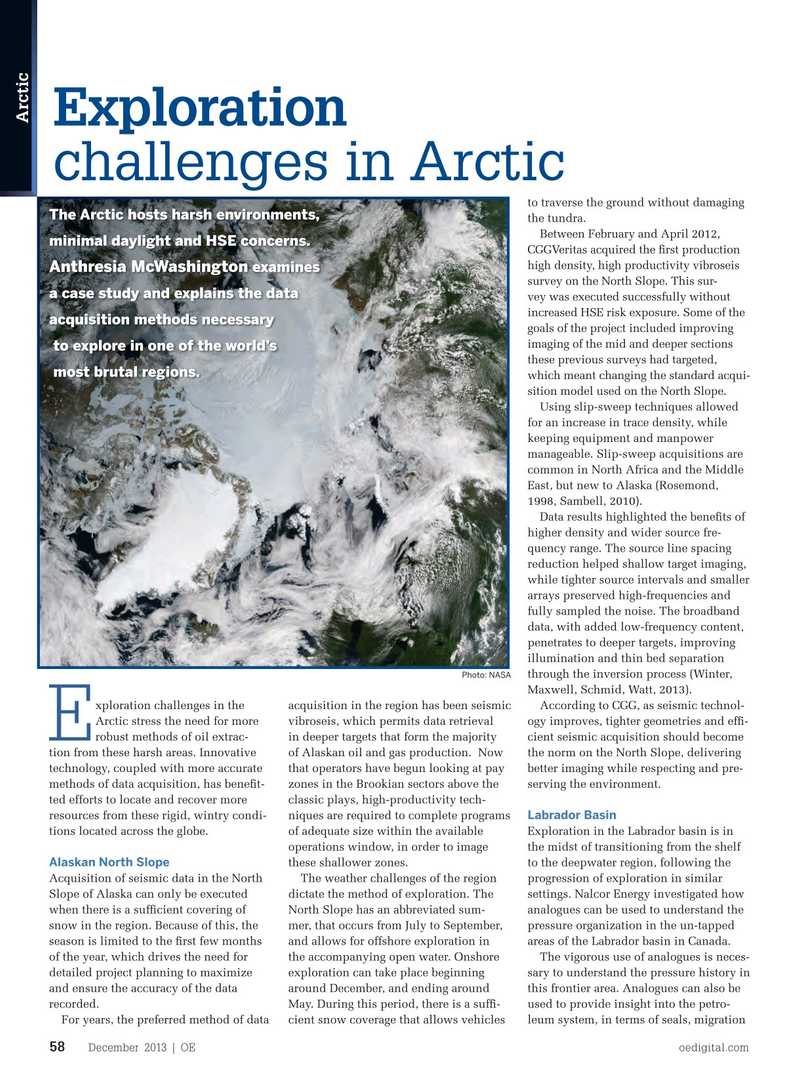
Page 56: of Offshore Engineer Magazine (Dec/Jan 2013)
Read this page in Pdf, Flash or Html5 edition of Dec/Jan 2013 Offshore Engineer Magazine
Arctic
Exploration challenges in Arctic to traverse the ground without damaging
The Arctic hosts harsh environments, the tundra.
Between February and April 2012, minimal daylight and HSE concerns.
CGGVeritas acquired the frst production high density, high productivity vibroseis
Anthresia McWashington examines survey on the North Slope. This sur- a case study and explains the data vey was executed successfully without increased HSE risk exposure. Some of the acquisition methods necessary goals of the project included improving imaging of the mid and deeper sections to explore in one of the world’s these previous surveys had targeted, most brutal regions.
which meant changing the standard acqui- sition model used on the North Slope.
Using slip-sweep techniques allowed for an increase in trace density, while keeping equipment and manpower manageable. Slip-sweep acquisitions are common in North Africa and the Middle
East, but new to Alaska (Rosemond, 1998, Sambell, 2010).
Data results highlighted the benefts of higher density and wider source fre- quency range. The source line spacing reduction helped shallow target imaging, while tighter source intervals and smaller arrays preserved high-frequencies and fully sampled the noise. The broadband data, with added low-frequency content, penetrates to deeper targets, improving illumination and thin bed separation through the inversion process (Winter,
Photo: NASA
Maxwell, Schmid, Watt, 2013).
xploration challenges in the acquisition in the region has been seismic According to CGG, as seismic technol-
Arctic stress the need for more vibroseis, which permits data retrieval ogy improves, tighter geometries and eff-
E robust methods of oil extrac- in deeper targets that form the majority cient seismic acquisition should become tion from these harsh areas. Innovative of Alaskan oil and gas production. Now the norm on the North Slope, delivering technology, coupled with more accurate that operators have begun looking at pay better imaging while respecting and pre- methods of data acquisition, has beneft- zones in the Brookian sectors above the serving the environment.
ted efforts to locate and recover more classic plays, high-productivity tech-
Labrador Basin resources from these rigid, wintry condi- niques are required to complete programs tions located across the globe. of adequate size within the available Exploration in the Labrador basin is in operations window, in order to image the midst of transitioning from the shelf
Alaskan North Slope these shallower zones. to the deepwater region, following the
Acquisition of seismic data in the North The weather challenges of the region progression of exploration in similar
Slope of Alaska can only be executed dictate the method of exploration. The settings. Nalcor Energy investigated how when there is a suffcient covering of North Slope has an abbreviated sum- analogues can be used to understand the snow in the region. Because of this, the mer, that occurs from July to September, pressure organization in the un-tapped season is limited to the frst few months and allows for offshore exploration in areas of the Labrador basin in Canada.
of the year, which drives the need for the accompanying open water. Onshore The vigorous use of analogues is neces- detailed project planning to maximize exploration can take place beginning sary to understand the pressure history in and ensure the accuracy of the data around December, and ending around this frontier area. Analogues can also be recorded. May. During this period, there is a suff- used to provide insight into the petro-
For years, the preferred method of data cient snow coverage that allows vehicles leum system, in terms of seals, migration
December 2013 | OE oedigital.com 58 058_OE1213_Arctic1.indd 58 11/22/13 4:39 PM

 55
55

 57
57